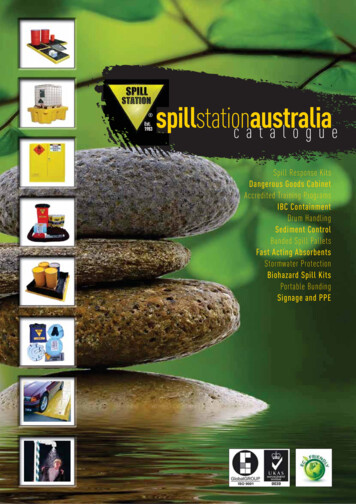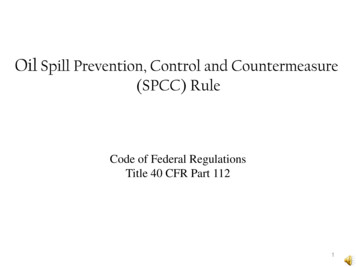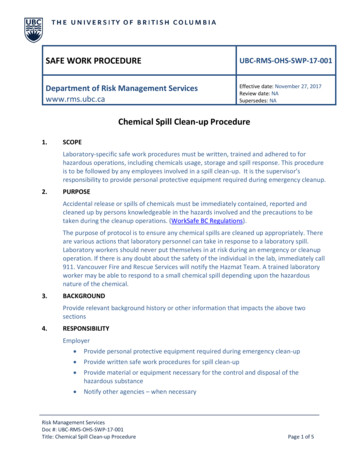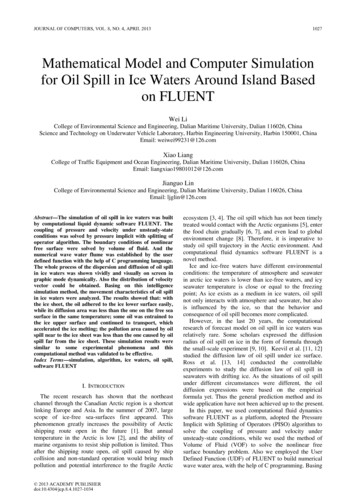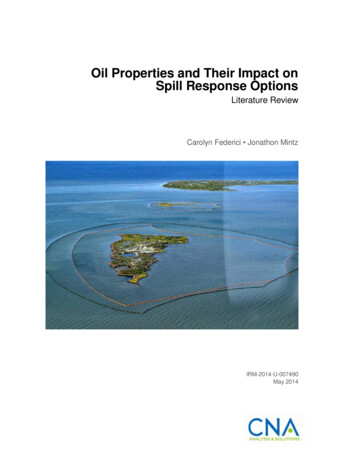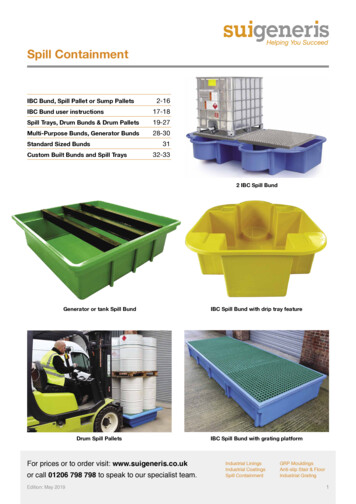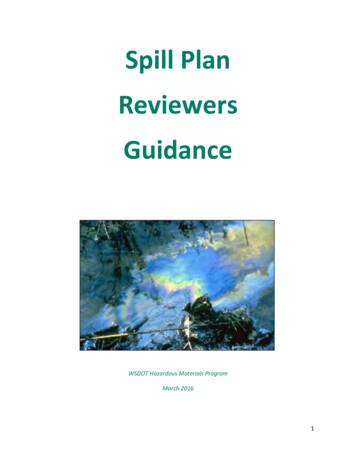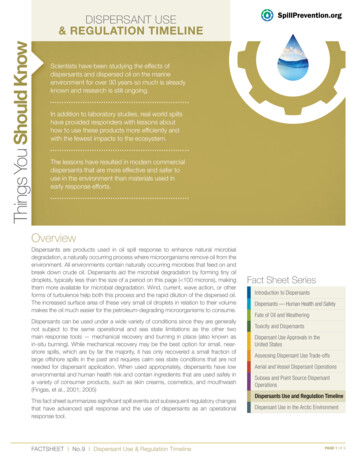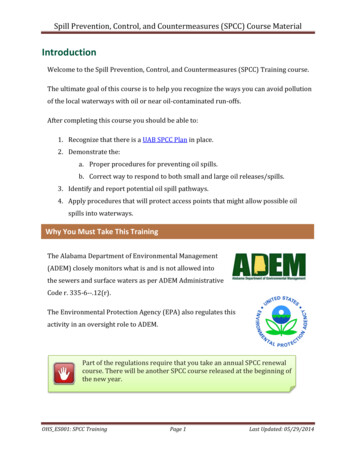
Transcription
Spill Prevention, Control, and Countermeasures (SPCC) Course MaterialIntroductionWelcome to the Spill Prevention, Control, and Countermeasures (SPCC) Training course.The ultimate goal of this course is to help you recognize the ways you can avoid pollutionof the local waterways with oil or near oil-contaminated run-offs.After completing this course you should be able to:1. Recognize that there is a UAB SPCC Plan in place.2. Demonstrate the:a. Proper procedures for preventing oil spills.b. Correct way to respond to both small and large oil releases/spills.3. Identify and report potential oil spill pathways.4. Apply procedures that will protect access points that might allow possible oilspills into waterways.Why You Must Take This TrainingThe Alabama Department of Environmental Management(ADEM) closely monitors what is and is not allowed intothe sewers and surface waters as per ADEM AdministrativeCode r. 335-6--.12(r).The Environmental Protection Agency (EPA) also regulates thisactivity in an oversight role to ADEM.Part of the regulations require that you take an annual SPCC renewalcourse. There will be another SPCC course released at the beginning ofthe new year.OHS ES001: SPCC TrainingPage 1Last Updated: 05/29/2014
Spill Prevention, Control, and Countermeasures (SPCC) Course MaterialDefinition of OilThis chart shows what the EPA definesas oil. This is not all inclusive, but itcovers the oils used here at UAB.The SPCC PlanBoth the State and Federal Spill Prevention ControlCountermeasures Rule includes requirements for:1. Oil spill prevention.2. Preparedness.3. Response to prevent oil discharges to navigablewaters and adjoining shorelines.4. Preparation, amendment, and implementation of SPCC Plans for facilities. Thosefacilities include: Above ground oil storage of more than 1,320 gallons. Underground oil storage of more than 42,000 gallons.Navigable WaterwaysThe SPCC Rule applies to storage of petroleum products in locations where a spill couldpotentially reach navigable waterways.Shown here is an oil spill that has made its way to a creek.OHS ES001: SPCC TrainingPage 2Last Updated: 05/29/2014
Spill Prevention, Control, and Countermeasures (SPCC) Course MaterialUnderground oil storage is not covered in this course. If you havequestions about underground storage of oil or oil products, please contactOccupational Health and Safety (OH&S) at (205) 934-2487.UAB’s SPCC PlanThe UAB SPCC Plan includes:1. A description of the oil storage locations on the UAB campus.2. A description of the secondary containment for oil storage.3. Maps or other information to indicate where a release will migrate.4. Spill history, potential spill sources, and spill prevention techniques.5. A spill contingency plan.6. Other applicable guidelines.This is a summary of UAB’s SPCC Plan. What we need you to remember is to dojob correctly when working with or around oil or oil-products.SpillsThere are two types of releases/spills.Large SpillsA large spill is anything 25 gallons or more of oil or anoil spill that has the potential of entering a naturalwaterway.Large releases/spills would most likely occur during: Loading or unloading operations. Catastrophic tank failure. Fuel tank failure during delivery.OHS ES001: SPCC TrainingPage 3Last Updated: 05/29/2014
Spill Prevention, Control, and Countermeasures (SPCC) Course MaterialLarge Release/Spill ResponseWhen a large release/spill occurs, you should:1. Immediately contact your supervisor/manager or David Hagan, Director of theEnvironmental Management Program. (205)-934-2487.2. If a large release/spill occurs at night, on a weekend, or on a holiday, pleasecontact the OH&S Director-On-Call. This information is located on the OH&Swebsite.Who to contactAs we've said before, a large release/spill is anything greater than 25 gallons OR anyquantity that has reached a surface water, sewer, ditch, or culvert leading to surfacewater.When a release/spill is large, immediately contact the UAB Emergency Coordinator. TheUAB Emergency Coordinator will respond and contact one or more municipal, state, orfederal agencies as well as be responsible for the oversight of the cleanup.The phone numbers of OH&S, the UAB Emergency Coordinator, and the Director-On-Callare listed on the OH&S website. You may want to post these numbers in locations near oillocations.Do NOT call the Birmingham Police, Fire Department, or any otherregulatory agency. This is the job of the Emergency Coordinator.OHS ES001: SPCC TrainingPage 4Last Updated: 05/29/2014
Spill Prevention, Control, and Countermeasures (SPCC) Course MaterialSmall SpillsA small spill is a spill of less than 25 gallons of oil – like the oneshown here. Small overfills at the fill port on fuel tanks Spills during transfers to or from tanks and containers Leaks or failures of oil handling equipment (tanks,containers, pipes, pumps)Small Release/Spill ResponseFollow these steps to properly clean up a small release/spill.1. Render (make) the area safea. Turn off the oil flow if possibleb. Notify personnel in the area.2. Put on the appropriate Personal Protective Equipment (PPE).3. Stop and/or contain the release as soon as possible.4. Protect all the drains and the bare ground in the area.5. Clean up the spill wiping from the outside of the release/spill toward the inside.Documenting1. Notify your supervisor, manager, and OH&S (if necessary)2. Document the details of the incident. Write down the cause of the release/spill. Record where it happened. Estimate and list the amount of the spill. Note the date and time of the release/spill. List details of how you cleaned up the release/spill. Explain how you disposed of the contaminated materials used to clean upthe release/spill.OHS ES001: SPCC TrainingPage 5Last Updated: 05/29/2014
Spill Prevention, Control, and Countermeasures (SPCC) Course MaterialWho to contactFor small releases/spills, notify your supervisor, manager, or Principal Investigator (PI).You may also notify the UAB Emergency Coordinator (or the designee) or the OH&Sdepending on the type, size, and location of the spill.ResponseBelow is a list of things you should know and do during an oil spill: Have enough spill control materials on hand to accommodate the release of thelargest container stored. Ensure that tanks, berms, and thresholds are high enough to contain the contentsfor removal. Use booms, spill pillows, loose absorbent (e.g., clay, kitty litter, etc.) container fordisposal of clean up waste. Wear the appropriate Personal Protective Equipment (PPE) when cleaning up aspill – the appropriate gloves, eyewear (if needed), and a disposable gown (ifneeded and if available to avoid contamination of your clothes).Click on the link to a video on How To Clean Up A Spill.OHS ES001: SPCC TrainingPage 6Last Updated: 05/29/2014
Spill Prevention, Control, and Countermeasures (SPCC) Course MaterialMaterialsThere are several types of materials that can be used to absorb oil from a spill:PortableSpill Berms(some arecalled pigs)Portable SpillBerms (someare calledpigs)Absorbent materials such aspaper towels, clay, kitty litter,peat moss, vermiculite, sawdust, old towels.Drain MatsDisposalOil Waste and Contaminated MaterialsDispose of all cleanup materials properly. Do not throw these in the regular trash! Properly package the oil waste and the contaminated materials used for cleanup. Label the package correctly use the instructions listed in the Hazardous WasteHandling and Packing course or use the job aids on the website to assist you. Follow the instructions listed inside the PDF file of the Hazardous Waste Manifestto accurately manifest the oil waste and the contaminated materials used forcleanup. Manifest submitted incorrectly will be returned for correction beforepickup.If you have not taken the hazardous Waste Handling and Packing course(CS055) within the last 365 days, your waste will not be picked up.Remember, there is an annual renewal requirement for the course.OHS ES001: SPCC TrainingPage 7Last Updated: 05/29/2014
Spill Prevention, Control, and Countermeasures (SPCC) Course MaterialAbove Ground Storage Container RequirementsThe following are requirements when working with and/or around Above GroundStorage Containers. Use secondary containment (such as large containers) to surround primarycontainers such as:o Spill palletso Raised thresholdso Sealed floorso Door lip - "runner"o Drip pano Constructed curbs or berms Drains in the secondary containment of outdoor Above Ground StorageContainers must be kept closed except to drain rain water. Rain water that collects in the secondary containment of Above Ground StorageContainers must be inspected for oil contamination (sheen) before being released. Inspections for leaks and spills in and around the containers must be performedregularly.Problems and IssuesIssues to avoidBelow are some common violations from other colleges and universities. You areresponsible for keeping these from becoming violations here at UAB. Designated staff do not conduct regular walk-through inspections of locations Small, scattered Above Ground Storage Containers, especially in dormitorylocations, are not adequately protected from tampering/vandalism Inadequate training and lack of training documentation Missing or inadequate secondary containmentOHS ES001: SPCC TrainingPage 8Last Updated: 05/29/2014
Spill Prevention, Control, and Countermeasures (SPCC) Course Material Failure to include vegetable oils/kitchen grease as regulated petroleum Failure to keep adequate documentation for past spillsUAB Common IssuesOH&S has noticed that there are a few common issues that we deal with frequently. If yousee these, please correct them as soon as possible.Spills going into stormdrainsNo secondarycontainers for someprimary containersKitchen greasestorage withspillageSummaryHere are a few things we want you take away from this training. Annual training is required for employees handling oil products. Releases/spills must be contained, cleaned up, and reported as soon as possible. Containers and tanks require appropriate secondary containment. Inspections must take place regularly. A complete spill kit (containing the appropriate items neededfor an oil release/spill) on location.OHS ES001: SPCC TrainingPage 9Last Updated: 05/29/2014
Spill Prevention, Control, and Countermeasures (SPCC) Course MaterialConclusionThis concludes the SPCC Training course. Please take the assessment at this time. 80% orhigher is required to pass. You may take the assessment three times. If you fail all threetimes, you will fail the course and have to take it again.For further assistance or information: Contact David Hagan, Director of the Environmental Management Program, viaemail at jdhagan@uab.edu or OH&S at(205)-934-2487. Visit the OH&S website at www.uab.edu/ohs.OHS ES001: SPCC TrainingPage 10Last Updated: 05/29/2014
Spill Prevention, Control, and Countermeasures (SPCC) Course Material OHS_ES001: SPCC Training Page 3 Last Updated: 05/29/2014 UA's SP Plan Large Spills The UAB SPCC Plan includes: 1. A description of the oil storage locations on the UAB campus. 2. A description of the secondary containment for oil storage. 3.
